Cite this document
(“An Examination of influence of Calligraphy in the Contemporary Graphic Essay”, n.d.)
An Examination of influence of Calligraphy in the Contemporary Graphic Essay. Retrieved from https://studentshare.org/miscellaneous/1527049-an-examination-of-influence-of-calligraphy-in-the-contemporary-graphic-of-eastern-culturekorea-japan-and-china
An Examination of influence of Calligraphy in the Contemporary Graphic Essay. Retrieved from https://studentshare.org/miscellaneous/1527049-an-examination-of-influence-of-calligraphy-in-the-contemporary-graphic-of-eastern-culturekorea-japan-and-china
(An Examination of Influence of Calligraphy in the Contemporary Graphic Essay)
An Examination of Influence of Calligraphy in the Contemporary Graphic Essay. https://studentshare.org/miscellaneous/1527049-an-examination-of-influence-of-calligraphy-in-the-contemporary-graphic-of-eastern-culturekorea-japan-and-china.
An Examination of Influence of Calligraphy in the Contemporary Graphic Essay. https://studentshare.org/miscellaneous/1527049-an-examination-of-influence-of-calligraphy-in-the-contemporary-graphic-of-eastern-culturekorea-japan-and-china.
“An Examination of Influence of Calligraphy in the Contemporary Graphic Essay”, n.d. https://studentshare.org/miscellaneous/1527049-an-examination-of-influence-of-calligraphy-in-the-contemporary-graphic-of-eastern-culturekorea-japan-and-china.


